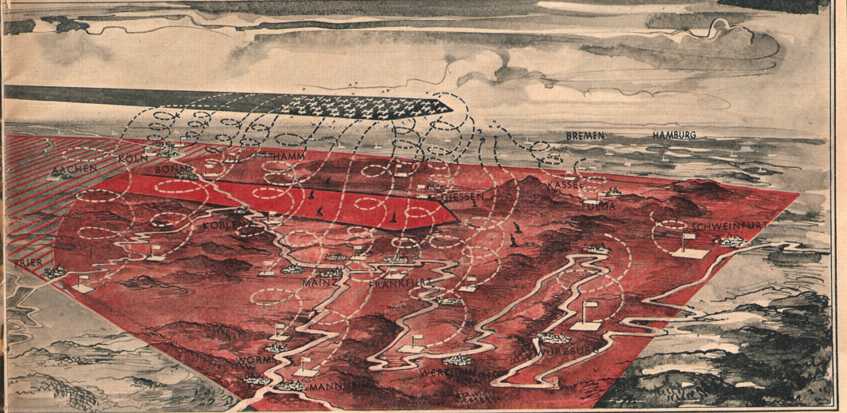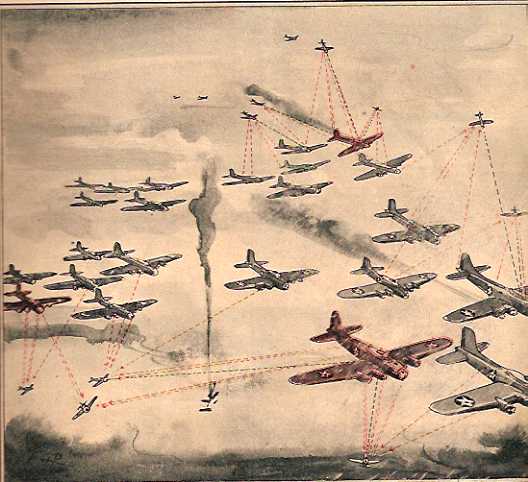


Background: Signal was a twice-monthly propaganda publication by the Nazis that appeared in numerous languages. By the end of 1943, Allied bombing was having devastating effects on German cities and the Luftwaffe seemed unable to stop it. This is one of two articles from the first issue of December 1943 that suggests that Germany is effectively resisting Allied attacks. It reports an American bombing attack against Schweinfurt on 14 October 1943, which did, in fact, suffer heavy losses, though not as heavy as the Germans claimed. Of the 291 B-17s in the attack, 59 were shot down over Germany, 6 crashed on the way home, and 12 landed in such poor condition that they were scrapped. The mission became known as “Black Thursday.”
The attack also turned out to be much less effective in hampering the German war effort than thought at the time. Schweinfurt was a site for the manufacture of ball bearings. The factories were harder to destroy than expected, and the Germans were able to import ball bearings from Switzerland and Sweden, so the effect on war production was minimal.
The source: Erwin Baas, “‘Americana’: Einmaleins um 121,” Signal, 1. December 1943, pp. 4-5.
The British and Americans expected that their terror attacks on German cities in 1943 would be successful. 18 = 43 was their slogan [i.e., Germany would collapse in 1943, just as it did in 1918]. People in the USA love to toss figures around. Suddenly, the OKW report announced the destruction of at least 121 US bombers on a single day in a single attack. This issue of Signal demonstrates what the destruction, one by one, of 121 bombers really means.

Fighters that will attack the bombers are spread throughout Western Europe. Wherever the bombers go, they encounter their most dangerous enemy, the fighter. The further they penetrate into Europe, the more fighter squadrons are alerted and join the aerial battle, according to plan. Every minute of the flight, both coming and going, fighters are on the flanks of the bombing formation, breaking planes out of the formation one by one. The foundation of this type of fighter attack is a precise and rapid system of control that alerts all fighter units along the flight path and guides them to the bomber formations.
A “Flying Fortress” of the type that suffered such heavy losses during a single attack has a so-called “structural weight” — the weight of the aircraft without weapons, bombs, and fuel — of about 18 tons. These aircraft have four turbocharged Wright Cyclone engines. These engines can generate 1200 horsepower at take-off, and about 1100 horsepower at 7,000 meters. The highest speed is about 450 kilometers an hour at 9,000 meters. To defend against fighters, the plane is armed with ten to twelve heavy machine guns.
121 bombers = 907.5 tons of duraluminum. During peace, that would fill two trains of 45 freight cars each with two million cooking pots. |
The crew consists of four officers and five enlisted men: two pilots, a navigator, a bombardier, two mechanics, two radiomen, and one tail gunner. During aerial combat, the whole crew, except for the pilots, mans the machine guns.
Of the 18 tons of structural weight, at least 40% is duralumin, or about 7.5 tons. The loss of 121 bombers on a single day, therefore, means the removal of 907.5 tons of duralumin from the American war effort. This 907.5 tons of duralumin, a welcome gift to the German war effort, would fill 90 freight cars with ten tons each, or two long freight trains. One could manufacture about two million cooking pots from this amount of aluminum.
Anglo-American losses are much greater than simply that, however. Aluminum comes from bauxite in a ratio of about 1 to 4. That means the Americans must transport 360 freight cars of bauxite to gain 90 freight cars of aluminum. Smelting this amount of ore requires about 25 million kilowatt hours of electricity, which corresponds to the daily amount of electricity used by an industrialized country of 20 million inhabitants.
The layman who looks into a complicated warplane sees a confusion of cables and instruments of various types and sizes. In the cockpit, the pilot has countless gauges measuring oil pressure, fuel, and hydraulics. Then there are the many instruments that allow for “blind flight”: an artificial horizon, magnetic and circular compasses, and gauges for elevation, speed, climbing, and descending. There are pressure gauges, tachometers, and readings from the engines, all of which come together in the cockpit. There are wing flaps, controls for the landing gear, and controls for the propellers.
121 bombers contain enough apparatus and equipment to provide 200,000 families with a radio. That is the equivalent of a city with half a million inhabitants. |
The navigator has just as much equipment that he needs for navigation, as well as for weather observation. The bombsight, with its complicated optical equipment, is a small work of art in itself.
The radiomen are surrounded by equipment for Morse Code, for voice communication, for sending and receiving. They are often small, which leads people to underestimate how difficult they are to manufacture. Besides their machine guns, the mechanics have an arsenal of equipment to take care of, although they hardly understand how it works. The complicated equipment of a modern bomber is about 20% to 30% of the manufacturing cost. With the labor and money it takes to build the apparatus and equipment of a single one of the 121 “Flying Fortresses” lost, 200,000 families could have received a good radio receiver.
Aircraft engines are not automobile motors. They cannot be manufactured on the assembly line in the same way as automobile engines are in large American factories. There are built on an assembly line, but the many thousands of parts must be tested thoroughly for weaknesses in material or construction. A small mistake in the smallest part of one of these engines will have disastrous results. Only careful work by skilled laborers can assure that the engines will run smoothly.
121 bombers = 36,300,000 hours of labor. During peace, Germany built 180 kilometers of Autobahn with equivalent labor. |
Building an aircraft engine, then, cannot be compared with the manufacture of thirty or forty automobile motors, but rather with the work and skill it takes to manufacture high-powered turbines. When 121 aircraft with 484 valuable engines are shot down, 532,400 horsepower are destroyed. That alone is more than Schweinfurt, the city attacked, needs to generate its light and electricity.
Ignoring the high crew losses, these plans also devour large amounts of American armaments labor. If one assumes that it takes 300,000 hours of labor to manufacture a “Flying Fortress,” it means that it took 36,300,300 hours of labor to manufacture these 121 bombers. The German Autobahn system offers a good comparison. With the same effort it took to manufacture 121 aircraft, we built 180 kilometers of Autobahn during the years before the war, including what it took to build two divided lanes and bridges. With the same effort one could build 7260 individual houses.
Mosaic Work....
 A formation of four-motored bombers bristles with
weapons. It is like a hedgehog, directing its bristles in all directions.
It is not easy for fighters to attack such a formation. Each large
bomber has ten to twelve large-caliber machine guns. And at the edges
of the formation, there are so-called “gun ships,” (shown
in red above), which carry no bombs, but instead about thirty machine
guns. The fighter than flew into this formation would be shot at by
several hundred guns. Therefore, the fighters attack the bombers at
the furthest edge of the formation. (The firing lines of the bombers
are shown in the above illustration.) Several fighters attack a single
bomber simultaneously. A mass attack on the formation does not work.
Instead, rather like a mosaic, the fighters attack here and there,
shooting one large bomber after another out of the formation.
A formation of four-motored bombers bristles with
weapons. It is like a hedgehog, directing its bristles in all directions.
It is not easy for fighters to attack such a formation. Each large
bomber has ten to twelve large-caliber machine guns. And at the edges
of the formation, there are so-called “gun ships,” (shown
in red above), which carry no bombs, but instead about thirty machine
guns. The fighter than flew into this formation would be shot at by
several hundred guns. Therefore, the fighters attack the bombers at
the furthest edge of the formation. (The firing lines of the bombers
are shown in the above illustration.) Several fighters attack a single
bomber simultaneously. A mass attack on the formation does not work.
Instead, rather like a mosaic, the fighters attack here and there,
shooting one large bomber after another out of the formation.
Last edited 25 April 2025
Page copyright © 2008 by Randall Bytwerk. No unauthorized reproduction. My email address is available on the FAQ page.
Go to the 1933-1945 page.
Go to the German Propaganda Home Page.